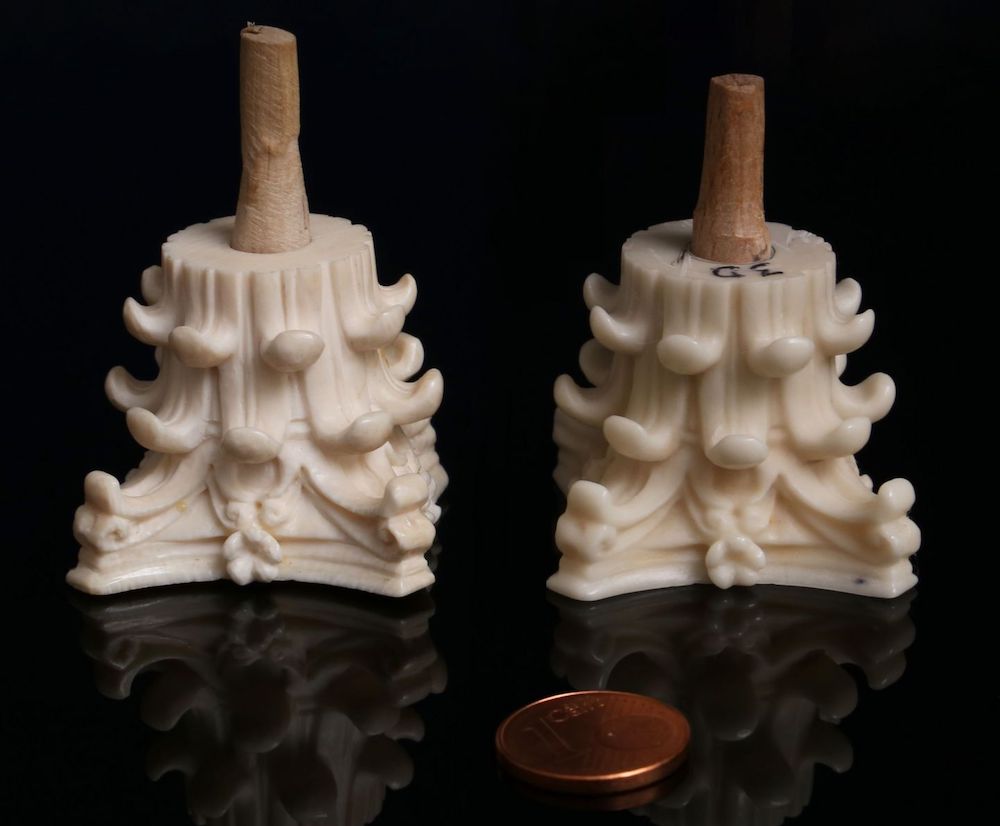
[Image above] The new substitute ivory material Digory (right) compared to natural ivory (left). Credit: TU Wien
Growing up in Iowa and surrounded by classmates involved in Future Farmers of America, I always knew where meat came from. When our high school English teacher showed us the opening scene from Food, Inc., which transitions from the picture of a happy cow in a big field to a densely packed cattle stockyard, our class struggled to understand why the contrasted imagery was considered so powerful and shocking when the movie came out.
Because production and consumption of products often occur in very different places, many people do not realize the impact their choices have on the flora and fauna of the producing region. Such was the case for elephants when ivory—a hard, white substance found in the tusks of animals—became all the rage during the last century.
“In the early 1900s, … the mass production of combs, brush handles, piano keys, and pool balls was fueling an ivory frenzy. By 1913, the United States was consuming 200 tons of ivory per year,” a National Geographic video explains. This frenzy resulted in the population of elephants, which stood at around 26 million in 1800, to drop to only 600,000 by 1989 as people killed them for their tusks.
In 1989, the Convention on International Trade in Endangered Species effectively banned the international commercial trade in African elephant ivory by classifying the species as “threatened with extinction” (Appendix I). While this move did stabilize the population somewhat, approval of two sanctioned sales of stockpiled ivory in 1999 and 2008 led to increased poaching that undid these gains. Today, there are thought to be around 415,000 African elephants left in total.
This situation presents an ethical question for preservationists working to restore or preserve cultural and religious artifacts made out of ivory. Even if “legal” ivory is used for the restoration, the sanctioned sales in 1999 and 2008 demonstrate that legal trade of ivory correlates with increased poaching. So, while substitute materials are generally discouraged in restoration work, there is support for using substitute materials when working with ivory.
Substitute materials for ivory include natural materials, such as bones, shells, or “vegetable” ivory like the Jarina seed, and synthetic materials, such as composites containing resin, casein, or ivory sawdust. The appearance and chemical composition of these substitutes differ, but they typically share one thing in common.
“These substitutes are mostly available as bulk and it can take a lot of time and effort to carve the desired shape. Especially delicate structures consume various resources,” researchers write in a recent open-access paper.
The researchers come from several institutions in Austria—the Vienna University of Technology (TU Wien); 3D printing company Cubicure GmbH, created as a spin-off of TU Wien; and two collaborators from the Archdiocese of Vienna’s Department for the Care of Art and Monuments and Addison Restoration, respectively.
In the paper, they argue developing a substitute material that can be processed with additive manufacturing technologies would help preservationists recapture the style of the original artist and, “hence, preserve the character and appearance of an art piece exactly as intended.”
To develop such a material, the researchers first needed to settle on an additive manufacturing technique, as different techniques require different material properties for successful processing. They decided on stereolithography, which uses the energy of light to cure liquid photopolymers, because it allows printing of objects in high resolution.
They chose a dimethacrylate resin as the foundation for the 3D printable material and then added tricalcium phosphate (TCP) particles to obtain translucency; color pigments were mixed into the white slurry to provide an ivory base color. After printing, the material was post-cured using a UV absorber to reduce excess polymerization caused by light scattering at the TCP particles, which could affect geometric accuracy and surface quality.
The final material, which they called “Digory” (digital ivory) in acknowledgement of the tendency to refer to 3D-printed materials as digital materials, contained 55 wt.% (30 vol.%) of TCP particles to match the translucency of natural ivory.
Measurements revealed that the density and hardness of Digory (1.78 ± 0.02 g cm−3; 35.7 ± 1.3 HV at a load of 200 g) is comparable to the density and hardness of ivory found in literature (1.7–1.9 g cm−3; ~35 HV). Three-point bending tests showed that the flexural modulus, flexural strength, and work of fracture values for Digory are of the same magnitude as those for natural ivory with transversal orientation, though natural ivory is more anisotropic.
In addition to comparable density and mechanical properties, color match to natural ivory is an important property to consider as well. The researchers briefly describe some post-processing handcrafting techniques to bring the color of Digory into alignment with natural ivory, such as staining the material with black tea and applying a coating of wax.
Though much of the paper focuses on how closely Digory matches natural ivory, the researchers emphasize that achieving a perfect match is not the goal.
“When imitating a natural material, especially one with a questionable source of origin, or when complementing or replicating a work of art or an historical object, it is important to keep a distinction between the original and the substitute. Such a defining feature should not disrupt the overall appearance, yet be easy to discover with non-distractive methods,” they write.
Because the mechanical properties of Digory are quite similar to real ivory, the researchers say the best way to distinguish Digory is via illumination with UV light. While synthetic substitutes absorb UV light and thus appear dull blue, ivory instead appears white or light blue fluorescent.
“Those identification marks ensure that the demands of the Charta of Venice, the international guidelines for preservation and restauration, are redeemed in using Digory for restauration,” they conclude.
The open-access paper, published in Applied Materials Today, is “Developing an ivory-like material for stereolithography-based additive manufacturing” (DOI: 10.1016/j.apmt.2021.101016).
Author
Lisa McDonald
CTT Categories
- Art & Archaeology
- Environment


